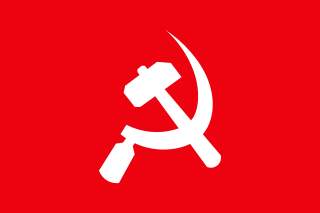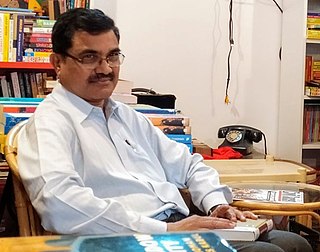
The Communist Party of India (Maoist) is a banned Maoist communist political party and militant organization in India which aims to overthrow the Republic of India through protracted people's war. It was founded on 21 September 2004, through the merger of the CPIML People's War and the MCCI. The party has been designated as a terrorist organisation in India under the Unlawful Activities (Prevention) Act since 2009.

Naxalism is the communist ideology of the Naxalites, a grouping of political and insurgent groups from India. It is influenced by Maoist political sentiment and ideology.
The red corridor, also called the red zone or according to the Naxalite–Maoist parlance the Compact Revolutionary Zone, is the region in the eastern, central and the southern parts of India where the Naxalite–Maoist insurgency has the strongest presence. The red corridor has been steadily diminishing in terms of geographical coverage and number of violent incidents, and in 2021 it was confined to 25 "most affected" and 70 "total affected" districts across 10 states in two coal rich, remote, forested hilly clusters in and around Dandakaranya-Chhattisgarh-Odisha region and tri-junction area of Jharkhand-Bihar and-West Bengal.

The Naxalite–Maoist insurgency is part of an ongoing conflict between left-wing extremist groups and the Indian government. The Naxalites are a group of communist supportive groups, who often follow Maoist political sentiment and ideology.

COBRA is a special operation unit of the Central Reserve Police Force (CRPF) of India proficient in guerrilla tactics and jungle warfare. Originally established to counter the Naxalite movement, CoBRA is deployed to address insurgent groups engaging in asymmetrical warfare. Numbering ten battalions as of 2011, CoBRA is considered to be one of the most experienced and successful law enforcement units in the country.

The Naxalite–Maoist insurgency is part of an ongoing conflict between Left-wing extremist groups and the Indian government. The insurgency started after the 1967 Naxalbari uprising and the subsequent split of the Communist Party of India (Marxist) leading to the creation of a Marxist–Leninist faction. The faction splintered into various groups supportive of Maoist ideology, claiming to fight a rural rebellion and people's war against the government.
Operation Green Hunt is the name used by the Indian media to describe the "all-out offensive by paramilitary forces and the states forces" against the Naxalites. The operation is believed to have begun in November 2009 along five states in the "Red Corridor."
The April 2010 Dantewada Maoist attack was an 6 April 2010 ambush by Naxalite-Maoist insurgents from the Communist Party of India (Maoist) near Chintalnar village in Dantewada district, Chhattisgarh, India, leading to the killing of 76 CRPF policemen and 8 Maoists — the deadliest attack by the Maoists on Indian security forces.

Greyhounds is a police special forces unit of the Andhra Pradesh and Telangana Police departments in India. Greyhounds specialises in counter-insurgency operations against Naxalite and Maoist terrorists.
Secession in India typically refers to state secession, which is the withdrawal of one or more states from the Republic of India. Whereas, some have wanted a separate state, union territory or an autonomous administrative division within India. Many separatist movements exist with thousands of members, however, some have low local support and high voter participation in democratic elections. However, at the same time, demanding separate statehood within under the administration of Indian union from an existing state can lead to criminal charges under secession law in India. India is described as a ‘Union of States’ in Article 1 of the Indian constitution I.e "Indestructible nation of destructible states" by its father of constitution Dr. Bhimrao Ramji Ambedkar where a state or Union territory of India cannot secede from India by any means and the Central Government has more powers than the respective state governments and can forcefully change the names and boundaries of the states without their permission at any time when needed for self interest and for the maintenance of integrity.

Anand Teltumbde is an Indian scholar, writer, and human rights activist who is a management professor at the Goa Institute of Management. He has written extensively about the caste system in India and has advocated for the rights of Dalits.
Narmada was an Indian politician who was one of the "senior-most" female cadres of the Communist Party of India (Maoist), a banned Maoist insurgent communist party in India. She was a Central Committee member of the party, and reportedly used to frame "all policies for the female cadre of Maoists."

Vinod Kumar Choubey, KC was an Indian Police Service officer who was killed during the Rajnandgaon ambush in July 2009, carried out by Maoist Naxalites. He became the first Indian Police Service officer in the state of Chhattisgarh to die as a result of Naxal violence. Choubey was posthumously awarded the peacetime gallantry award "Kirti Chakra" by then President of India Pratibha Devi Singh Patil.
On 25 May 2013, Naxalite insurgents of the Communist Party of India (Maoist) attacked a convoy of Indian National Congress leaders in the Jhiram Ghati, Darbha Valley in the Sukma district of Chhattisgarh, India. The attack caused at least 27 deaths, including that of former state minister Mahendra Karma and Chhattisgarh Congress chief Nand Kumar Patel. Vidya Charan Shukla, a senior Congress leader, succumbed to his injuries on 11 June 2013.
The Sukma attack was an ambush carried out by the Communist Party of India (Maoist) against Indian paramilitary forces on 24 April 2017, during the Naxalite-Maoist insurgency. It was the largest ambush since a similar attack in 2010, in the neighbouring district of Dantewada.
The 2018 Riots of Koregaon Bhima refers to violence during an annual celebratory gathering on 1 January 2018 at Koregaon Bhima to mark the 200th anniversary of the Battle of Koregaon Bhima. The violence and stone pelting by a crowd at the gathering resulted in the death of a 28-year old youth and injuries to five others. The annual celebration, also called Elgar Parishad convention, was organised by retired justices B. G. Kolse Patil and P. B. Sawant. Justice Sawant stated that the term "Elgar" meant loud invitation or loud declaration.
The New Peace Process is an initiative of a conglomerate of tribal and non-government support groups and individuals, with the aim of bringing a negotiated settlement to the 50-year-old Maoist insurgency in Central India. Bastar Dialogues are a series of activities that started in mid 2018 by the New Peace Process to initiate a dialogue between the Naxalites and state security forces to restore peace in Central India.
The 2021 Sukma-Bijapur attack was an ambush carried out by the Naxalite-Maoist militants from the Communist Party of India (Maoist) against Indian security forces on 3 April 2021 at Sukma-Bijapur border near Jonaguda village which falls under Jagargunda police station area in Sukma district of Chhattisgarh, the ensuing gunfight lead to the killing of 22 security personnel as well as 20 Naxalites. The death toll was the worst for Indian security forces fighting the Naxalites since 2017.
Milind Baburao Teltumbde was an Indian Maoist insurgent leader and Central Committee member of CPI (Maoist). He is the younger brother of Dalit activist and scholar Anand Teltumbde. He was killed in the Gadchiroli clash.
The District Reserve Guard (DRG), also known as the District Reserve Group, is a specialized police unit formed in 2008 in the Indian state of Chhattisgarh to address left-wing extremism, particularly the Maoist insurgency. The unit was established as a response to the growing influence and violence of Maoist groups, which have historically taken advantage of the socio-economic conditions of local tribal populations. The DRG is often referred to as the "son of the soil" due to its composition of local recruits. As of 2021, the DRG consists of approximately 3,500 personnel.





